This chapter presents the current state of regional integration in research and higher education in the Euro-Mediterranean region and discusses indicators for monitoring integration and collaboration. It is based on data on research funding (including from abroad), scientific personnel, scientific co- publications, co-inventions, student and researcher mobility stocks and flows, and the internationalisation of higher education and research institutions and infrastructure. The chapter makes the case for a more holistic approach that links international co-operation in higher education and research with national reforms to connect, at the national level, the higher education and research systems of countries with industry as a way to enhance the quality of research and knowledge spill-overs for the benefit of society and the economy. Finally, it draws attention to the need to invest in, and grant access to, digital education and research infrastructures in order to accelerate regional integration through research and higher-education policies.
Regional Integration in the Union for the Mediterranean

5. Research and Higher Education
Abstract
Key takeaways
Regional cooperation in research and higher education can help improve the quality of skilled labour as well as promote the diversification of economic activities. It can also help provide solutions to shared problems such as security, energy, transport and tele-communications infrastructures, clean water, and sustainable agriculture and fisheries.
Regional integration in research and higher education requires pre-conditions to be met. Countries on both sides of the Mediterranean must invest in their own national science and technology capacities to be able to absorb foreign technology, and exchange knowledge and technologies. Building strong linkages between research, education and industry at the national level– the knowledge triangle - plays an important role in attracting higher value added foreign investments by multinational firms and in enabling international co-operation.
Key indicators for monitoring regional integration in higher education and research show that integration in the Euro-Mediterranean region has increased unevenly in line with the growing but unequal capacity in research and higher education in Southern Union for the Mediterranean (UfM) countries and the Western Balkans.
The intensity of research co-operation is characterized by North-South interactions and less by South-South collaboration although there are exceptions (e.g. Egypt-Saudi Arabia, Morocco-Israel). Most research co-operation is organised around physical sciences and chemistry, as well as life sciences, areas which are important to industrial development. Scientific co-operation in the environmental sciences is less strong both in the Southern Mediterranean countries and EU countries compared to other disciplines.
Mobility of students is an important channel for regional integration in research and higher education. Mobility to EU shows a sustained increase from Southern Mediterranean countries.
Based on co-patenting data, France and Germany are the main partners in innovation for Southern Mediterranean countries.
Several UfM countries have increased their investments in research and development (R&D) over the past decade in particular Israel, Egypt and Algeria.
An important challenge in monitoring regional integration and co-operation in the area of research and higher education in the Euro-Mediterranean region is the lack of data in countries that have historically low levels of investment in research and higher education.
Introduction
Recent changes to the global economy – in particular, the digital transformation that has accelerated following the COVID-19 pandemic – are modifying global production and affecting the ability of countries to follow regional integration strategies based on trade and foreign investment policies. Changes in trade patterns, the increased use of automation in manufacturing, and a trend toward regional re-shoring in sectors pose several challenges to the ability of Euro-Mediterranean and Western Balkan countries to move up the value chain and increase participation in the global economy. With the drop in trade and foreign direct investment (FDI) flows, countries must look towards structural reforms to reshape their economies (World Bank, 2020[1]). Promoting structural change in the economies of the region through regional co-operation in higher education and science will be critical to the ability of countries to seize opportunities in this changing global context.
The areas of research and higher education are not prima facie a direct focus of regional integration policies that aim to reduce divisions and market barriers to trade and exchange. However, as this chapter argues, complementary policies are also needed in research, higher education and innovation to accompany efforts to integrate national economies at the regional level.
Regional integration in research and higher education requires pre-conditions at the national level. For one, it requires that countries share a vision and commitment to research and education as a source of their own country’s economic and social development. Without the internal integration of research and higher education, with industry, including manufacturing and services, within national economic systems, there is a risk that regional collaboration among scientists and universities advances scientific knowledge and strengthens educational linkages but does not contribute sufficiently to the economic development of countries in the region. As argued by (Fagerberg, 1990[2]), a science-push approach has little impact on market structure. In contrast, innovation, which comes from the interaction of science and education with the market, creates learning processes between the users and producers of knowledge and technologies, leading to productivity increases and economic growth.
It follows then that integration in the Euro-Mediterranean region requires not only removing barriers to the movement of goods, ideas and people. It also requires investment in national capabilities for science and technology, including higher education and researcher training, the development of national research funding agencies, large-scale research infrastructures, and joint research centres and laboratories – as well as research mobility programmes, dedicated national research funds for collaborative research, and R&D platforms to match supply and demand for technical services. Embracing digitalisation in research will be equally important. These investments must be significant enough to help countries solve problems through domestic research, but also sufficient to enable international co-operation in higher education and research, help attract foreign investment, and foster knowledge exchange.
Promoting regional integration through stronger linkages between business, research and higher education: the Knowledge Triangle
Knowledge generated by education and research institutions has the potential to help local firms move up the value chain and diversify production, bringing about structural change. For this to happen, certain pre-conditions must be met. First, research and higher education must be strongly connected within countries at the policy level, the institutional level, and the place-based or economic geography level. This internal integration is known as the “Knowledge Triangle” (KT) (Figure 5.1). The KT concept relates to the need to improve the impact of investments in three areas – education, research and innovation – through systemic and continuous interaction. Its main idea is that creating new knowledge from research and higher education is in itself not enough to generate economic growth; rather, a constant interaction between the main actors of the KT is needed to make economically viable innovation possible. In other words, research should be mobilised through relations with the larger society, including businesses but also entrepreneurs to transform this knowledge into tangible innovation.
The KT concept places a specific focus on entrepreneurship as a channel to diffuse knowledge and innovation generated and to foster greater societal engagement. Higher education institutions (HEIs) are being encouraged not only to educate and train entrepreneurs to apply knowledge but also to locate entrepreneurial activities on campus. This is a rational development as entrepreneurship is a main channel through which knowledge developed at HEIs find their way into innovation.
Figure 5.1. The Knowledge Triangle approach
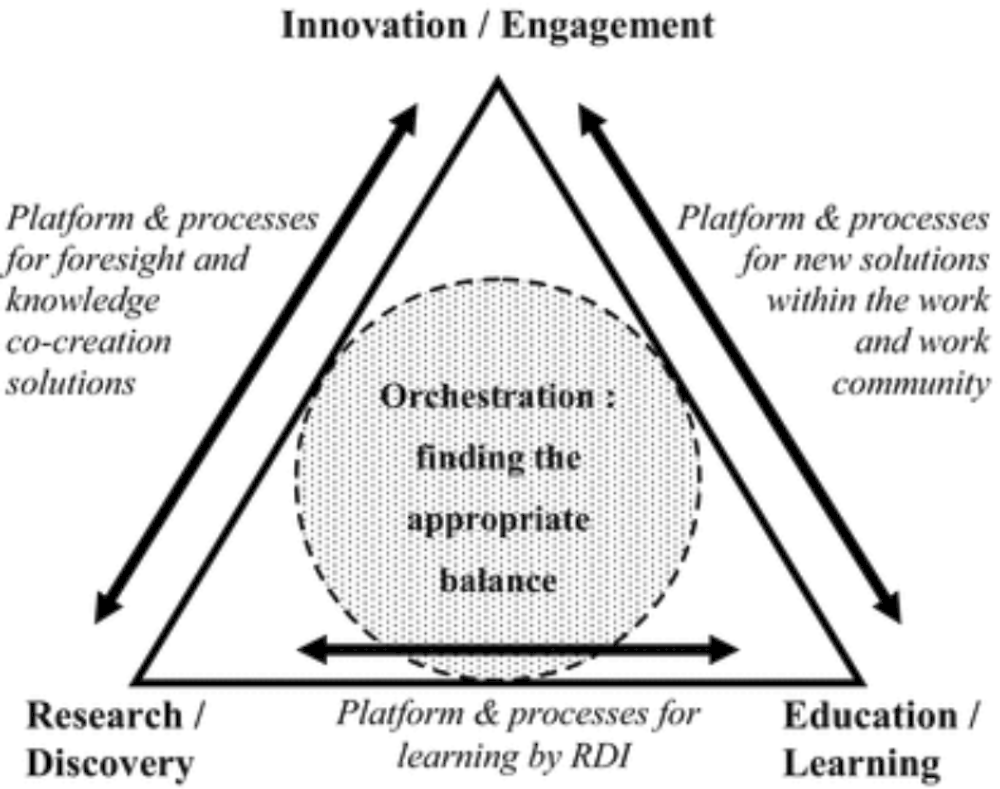
Source: (Sjoer, Nørgaard and Goosens, 2011[3]).
HEIs are the main backbone of the KT, because they provide key inputs for each corner of the KT but also because – depending on their specific portfolio regarding the provision of education, research and innovation – they often institutionally incorporate the KT in their internal organisation and missions.
The KT framework is not a silver bullet for integrating domestic production with research and higher education. There are both potential complementarity and potential conflicts between research, education and innovation policies. To mitigate against potential conflicts in the missions and focus of higher education and research institutions, co-ordination and dialogue is essential between the different ministries, funding agencies and institutions as well as place-based actors such as local governments (Cervantes, 2017[4]).
Internationalisation of knowledge and technology: A multifaceted phenomenon moving at different speeds
It is useful to place the internationalisation of higher education and research in the Euro-Mediterranean region in a broader context. The main channels through which knowledge and technology are diffused globally are market-based channels: net foreign direct investment (FDI) inflows, imports of manufactured products, imports of ICT and business services, payments for the use of intellectual property rights, and tertiary education abroad. Data show that even when adjusting for the technology content, imports of manufactured products are by far the largest mode of technology transfer to lower income countries (Figure 5.2). Business service imports and FDI are the second- and third-largest sources of technology flows, although FDI is less important for low-income countries. Similarly, while payments for the use of intellectual property rights (IPR) are important for high-income and upper-middle-income countries, they are much less so for low-income countries (United Nations, 2020[5]).
Figure 5.2. Distribution and significance of STI flows to advanced and developing countries
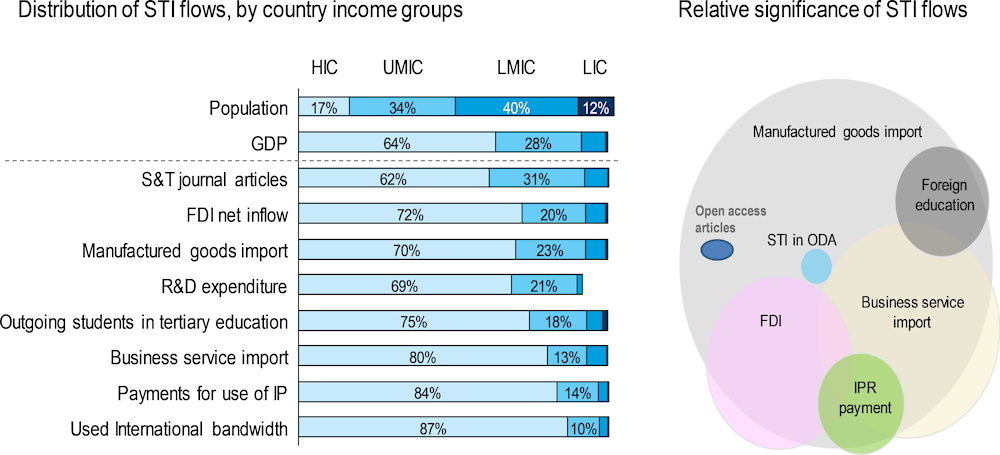
Note: HIC (high-income countries), UMC (upper-middle-income countries), LMIC (lower-middle-income countries) and LIC (low-income countries) are defined according to the World Bank Classification. STI = science, technology and innovation. GDP = gross domestic product. S&T = science and technology. FDI = foreign direct investment. R&D = research and development. IP = intellectual property, ODA = official development assistance.
Source: OECD, adapted from (United Nations, 2020[5]).
Furthermore, the literature on the internationalisation of business R&D shows that higher education and research conditions in the host countries play an important role in the location decisions of multinational firms. Supply-side factors, such as the host country’s technological infrastructure, the presence of local universities and skilled personnel with links to local companies, are important drivers of R&D internationalisation among businesses (OECD, 2008[6]) (OECD, 2017[7]) (Box 5.1).
Box 5.1. The Partnership for Research and Innovation in the Mediterranean Area (PRIMA)
International co-operation in public research is generally based on mutual interest, sharing the costs of research infrastructure, and improving the quality of research publications and the training of researchers. Although co-operation in scientific networks is driven primarily by the “bottom up” priorities of individual researchers, universities and research organisations, governments provide “top down” priorities for collaboration, especially when it comes to funding for scientific and economic diplomacy such as the PRIMA programme between EU and Mediterranean countries.
PRIMA represents a major EU effort at science diplomacy – using R&D projects to try to build bridges across the Mediterranean and thereby strengthen political relations. PRIMA consists of EU member states (Horizon, 2020[8]). Associated Countries and Mediterranean Partner Countries on an equal footing basis (co-ownership, co-management and co-funding), with the participation of the European Commission. The focus of PRIMA-funded research is to help countries in the region jointly tackle environmental and social changes brought about by climate change, such as depletion of agro-food systems and water resources. The increased complexity and multidimensionality of such social, economic and environmental challenges can be tackled only through common efforts and resources with a research and innovation approach. The partnership is financed through a combination of funding from PRIMA Participating States (currently €274 million) and a €220 million contribution from the EU through (ibid). The 19 participating countries are: Portugal, Spain, France, Italy, Malta, Slovenia, Croatia, Greece, Cyprus, Turkey, Lebanon, Jordan, Israel, Egypt, Tunisia, Algeria, Morocco, Germany and Luxembourg.
Source: PRIMA (2020), http://prima-med.org.
In contrast to market flows of knowledge, flows from higher education and research are less important globally. While the percentage of students studying abroad at the tertiary level is important among upper middle and high-income countries, the share from low- and middle-income countries is much smaller than their share of gross domestic product (GDP) or population (United Nations, 2020[5]).
Education reforms in many countries that encourage accountability and autonomy, as well as competition for students and research funding, have enforced institutions to better differentiate themselves and their education market offerings. The reforms to universities have also incentivised them to develop internationalisation strategies to boost their attractiveness to foreign students.
Meanwhile, research policies over the past decade have focused on increasing the contribution of research to innovation through legislative reforms and the establishment of hard and soft infrastructure in the form of technology transfer offices or other interfaces between public research and industry. Moreover, collaboration with public research, whether in the form of science – the “push” transfer of public research results to industry or “demand-pull” initiatives such as public-private partnerships – has become the dominant discourse and a key focus of innovation policies. More recently, with the advent of digital technologies that enable co-operation, the promotion of collaborative platforms that involve a broader range of actors – not just business and public research – has become a focus of research policies, particularly in OECD countries (Box 5.2).
Box 5.2. Increasing productivity and job benefits from collaboration in research, education and innovation
Collaborative platforms are emerging forms of public-private and private-private partnerships in which participants co-develop new technologies that might have significant potential for innovation and for improving well-being. Many governments – along with partners in industry, start-ups, and civil society – are developing experimental forms of these collaborative platforms to provide better linkages between research and innovation, and to promote commercialisation.
New kinds of collaborative platforms are arising in response to a number of key trends, and there has been shift of national and international research and development programmes to more open and participatory modes. These developments in innovation policy reflect a growing awareness of the creative potential of being more inclusive not only in reaping the benefits, but also along the process of innovation itself.
Connecting across multiple jurisdictions requires different kinds of collaboration. Collaboration and data sharing across national boundaries face several difficulties due to different perspectives, disparate geography, and ethical and legal issues. Common frameworks need to set out common practices of research and data sharing (OECD, 2017a[9]). This includes the development of information technologies to promote discoverability of data and sharing, and the promotion of regulatory approaches – in close coordination with policy makers, industry, and often civil society if privacy is at stake. Policy can support public-private partnerships by providing guiding principles on ethical, legal and IT-related matters.
To address this issue, in 2011 UNESCO launched a regional initiative called NECTAR – the Network for Expanding Converging Technologies (nanotechnology, biotechnology, ICTs) in the Arab Region – which is intended to strengthen national innovation systems by promoting partnerships between academia, research and industry. It also aims to stimulate an entrepreneurial culture that links basic and new sciences and their conversion into wealth. NECTAR is meant to identify regional science, technology and innovation priorities and help member countries fulfil them.
Collaborative platforms complement regulatory approaches. They can bridge national regulatory boundaries by setting internationally agreed standards surrounding the use of emerging technologies, and provide guidance for risks associated with their application. Collaborative arrangements can be more flexible than state regulation (Ansell and Gash, 2007[10]) (Folke et al, 2005[11]). In the context of emerging technologies, where change is fast and often unpredictable, platform-based models are flexible arrangements that can spur data-sharing and the discussion of norms around the use of converging technologies – while also supporting the development of markets and playing a role in shaping them (Gawer, 2014[12]).
Source: (OECD, 2021[13]).
Monitoring regional co-operation and integration in research and higher education
An important challenge in monitoring regional integration and co-operation in the area of research and higher education in the Euro-Mediterranean region is the lack of indicators in countries that have historically low levels of investment in research and higher education. Some UfM economies, including those that are also members or Participants in the OECD, have put in place systems for collecting, compiling, and publishing detailed data about their research and higher education efforts. Many countries in the Western Balkans, Africa, the Middle East and elsewhere have made progress in participating in the international data collection efforts of the World Bank, UNESCO or the EU, but data coverage remains incomplete, especially as regards longitudinal data (i.e.data that track the same sample at different points in time). These limitations make it difficult to measure not only the inputs and outputs of national research and innovation systems but also the linkages within and between national innovation systems.
Several countries have intensified their international activities, including explicit international co-operation strategies, and have improved data collection to assess the efficiency of co-operation. Other countries have regular indicator systems in place to map internationalisation of their national science, technology and innovation (STI) system. For example, in France, the specialist public institute Science and Technology Observatory (OST) provides regular reports on STI activities and performance, both within France and globally. The institute also publishes indicators on international co-publication on a regular basis, and issues specific, one-off studies on the co-publication profile of their research community. However, this practice is neither uniform across countries nor is it widespread and systematic. Other countries, such as Germany, have commissioned ad hoc studies on the internationalisation of research by looking at mobility and co-publication patterns as well as data on institutional strategies and patterns. This reflects a will to underpin strategy development process with empirical data on the individual and the institutional level (Edler and Flanagan, 2008[14]).
In terms of internationally comparable statistical indicators, the OECD and UNESCO lead the world in the production of indicators in the area of science and technology, monitoring investments in knowledge assets such as R&D, higher and vocational education, and ICTs. OECD databases also cover collaboration at the national level and internationally. The number of scientific articles co-authored by researchers affiliated with institutions located in different countries; co-invention or co-patents by inventors located in different countries – these indicators demonstrate the output, intensity and direction of the international co-operation. These indicators underpin efforts to monitor policy targets against input and output indicators. The key indicators used in this chapter are presented in Table 5.1. It should be noted that some of these indicators can be combined with other data, such as population data, to create additional indicators of efficiency – for example, the share of publications, patents, or co-authored publications per population.
Table 5.1. Key Indicators for monitoring integration and co-operation in public research and higher education
|
Indicator |
Description |
Coverage |
Frequency |
|---|---|---|---|
|
Indicator R1. Gross expenditure on tertiary education as a share of GDP. |
It covers public and private expenditure on tertiary education as a share of GDP. Source: OECD Education Database and UNESCO |
UNESCO covers most UfM member states |
Annual, last available 2018 |
|
Indicator R2. Gross expenditure on R&D as share of GDP |
This indicator is based on the Frascati manual definition of R&D and covers government, higher education, business and foreign funding. Source: OECD STI database UNESCO |
UNESCO covers all UfM member states OECD covers northern Mediterranean UfM plus Israel |
Annual, last available July 2020 |
|
Indicator R3. Gross expenditure funded from abroad |
These indicators measure the share of gross expenditures on R&D (BERD) coming from international sources. Indicators are available as share of GERD or business R&D (BERD). Source: OECD MSTI indicators |
OECD and Partner countries |
Biannual, last available year 2018 |
|
Indicator R4. R&D personnel |
This indicator covers the share of R&D personnel per population. R&D personnel are represented in full-time equivalent units. Source: OECD STI database and UNESCO Institute of Statistics |
OECD and Partner countries, UNESCO covers UfM member states |
Annual, last available July 2020 |
|
Indicator R5. Co-publication |
This indicator measures how many scientific publications were co-authored by researchers affiliated with institutions in different countries. Data are also available by scientific field of co-operation. Source: OECD STI database Nature Index Scopus Web of Science |
Partial coverage of all UfM member states |
Annual, last available July 2020 |
|
Indicator R6. Co-patenting |
This indicator measures the number of patent applications co-submitted by inventors in different countries. Source: OECD PATSTAT; EPO; WIPO |
All UfM member states |
Annual, last available year 2018 |
|
Indicator R7. Tertiary-level mobility |
This indicator measures the participation of tertiary-level students in a country’s education system. Source: OECD Education Statistics, UNESCO OECD international migration database |
All UfM countries |
Annual, last available year 2018 |
|
Indicator R8. Researcher mobility programmes |
This indicator measures the number of researchers receiving mobility grants from the Marie Curie Skodowska Action (MSCA) Programme, by origin and destination. Source: EU Marie Curie Programme database |
EU member states EU Associates Third Countries |
Annual, last available year 2018 |
|
Indicator R9. Funding and participation in Horizon 2020 Programmes |
This indicator measures the amount of funding from Horizon 2020 programmes received by associate and third countries as well as the number of countries participating in specific research co-operation programmes. Source: EU |
EU member states EU Associates Third Countries |
Annual , last available year 2019 |
* Meso level refers to indicators between macro and micro levels.
Indicator R1. Government expenditure on tertiary education as a share of GDP
Gross expenditure on tertiary education is important as it yields private and social returns. Individuals with tertiary education have higher employment outcomes and enjoy higher wages. Society benefits from higher education as workers engage in knowledge-based activities in business, government and public research sectors, to name a few. UfM countries vary greatly in their effort to invest in tertiary education (Figure 5.3). Some countries such as Morocco and Tunisia invest a relatively high share of GDP on tertiary education. While not a direct measure of regional integration, this indicator illustrates the ability of a country to provide tertiary education to domestic and international markets. As countries become wealthier, they can invest more in higher education. At the same time as education levels rises, the potential for the emigration and mobility of tertiary level students increases, especially towards high-income countries that have established selective immigration policies to attract foreign talent.
Figure 5.3. Government expenditure on tertiary education as a percentage of GDP
Total tertiary education (ISCED 2011 levels 5 to 8), 2000 and 2017
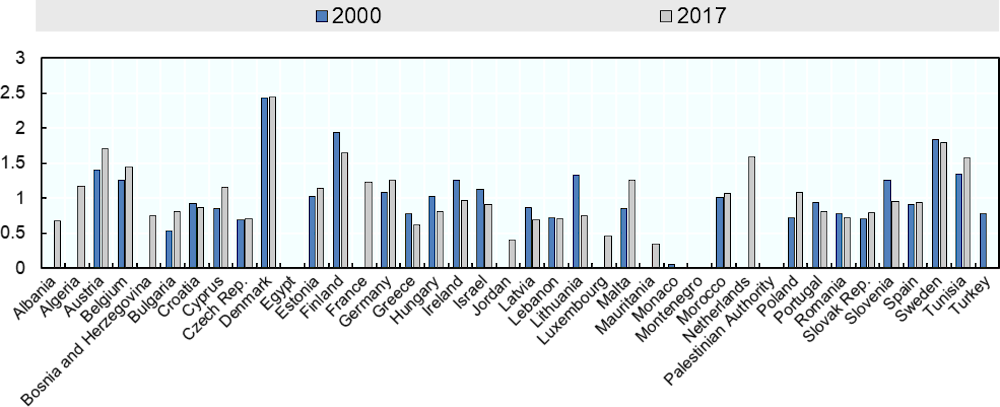
Note: ISCED (2011) is the International Standard Classification of Education 2011; see http://uis.unesco.org/en/topic/international-standard-classification-education-isced.
Source: UNESCO Institute for Statistics (UIS.Stat) (2020), http://data.uis.unesco.org.
Indicator R2. Gross expenditure on R&D as share of GDP
Gross domestic expenditure on R&D (GERD) is defined as the total expenditure (current and capital) on R&D carried out by all resident companies, research institutes, university and government laboratories, etc. in a country. Research is original investigation undertaken to acquire new knowledge; experimental development builds upon research to produce new or improved products or processes. OECD data on gross domestic spending on R&D are primarily collected through surveys of R&D performing organisations according to guidance in the OECD Frascati Manual. Expenditure is identified as relating to (basic or applied) research or experimental development; this can be challenging in some cases – particularly for expenditure on capital inputs to R&D or certain sectors (notably higher education) – and can cause the breakdown to be unavailable in part or in full. Data coverage in OECD STI databases is limited to UfM countries that are OECD members and participants, therefore among Southern Mediterranean countries, only Israel is covered. Figure 5.4, drawn on data collected by UNESCO’s Institute for Statistics, shows that several UfM countries have increased their investments in R&D over the past decade, in particular Israel, Egypt and Algeria. In contrast, Montenegro has fallen back.
Figure 5.4. Gross domestic expenditure on R&D (GERD)
As a percentage of GDP, 2008 and 2018, selected UfM economies
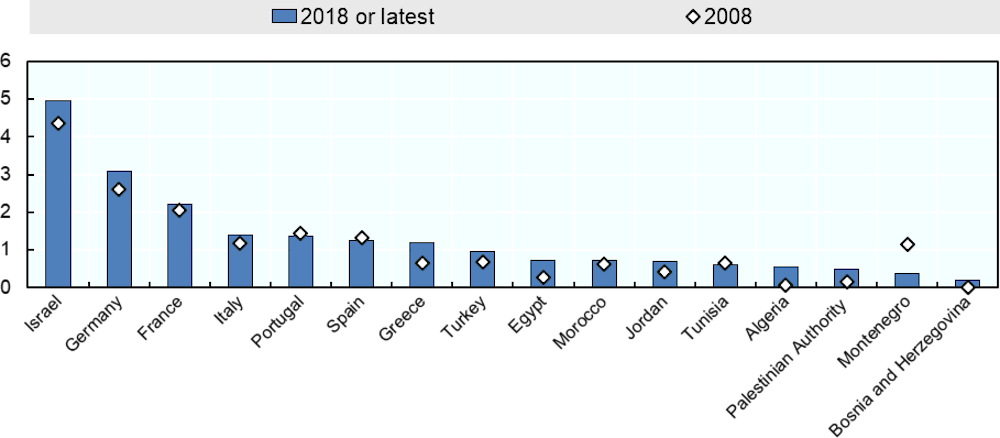
Note: For Turkey, data refer to 2008 and 2017. For Morocco, data refer to 2006 and 2010. For Jordan, data refer to 2008 and 2016. For Algeria, data refer to 2005 and 2017. For Palestinian Authority, data refer to 2013. For Montenegro, data refer to 2007 and 2018.
Source: The UNESCO Institute for Statistics (2020), UIS.Stat, http://data.uis.unesco.org.
Indicator R3. Gross expenditures on R&D from abroad
Another indicator that can be used to monitor the co-operation between different countries in the context of regional integration concerns the share of funding coming from abroad. Figure 5.5 shows the share of R&D funded from abroad; this includes R&D performed by subsidiaries of foreign-owned companies, R&D undertaken under contract on behalf of companies based abroad, and research grants from international organisations. On average, funding from abroad plays quite an important role in the funding of business R&D. In EU countries it represents between 5 and 10% of total expenditure. In Southern UfM economies, with the exception of Israel and the Palestinian Authority, foreign funding accounts for 5% or less. The weight of foreign multinationals in the economy and in the domestic production of technology matters: in Austria and Ireland funds from abroad represented close to 15% or more of total GERD; in Israel, over 40%.
Figure 5.5 Percentage of GERD financed by the rest of the world (2009 and 2017)
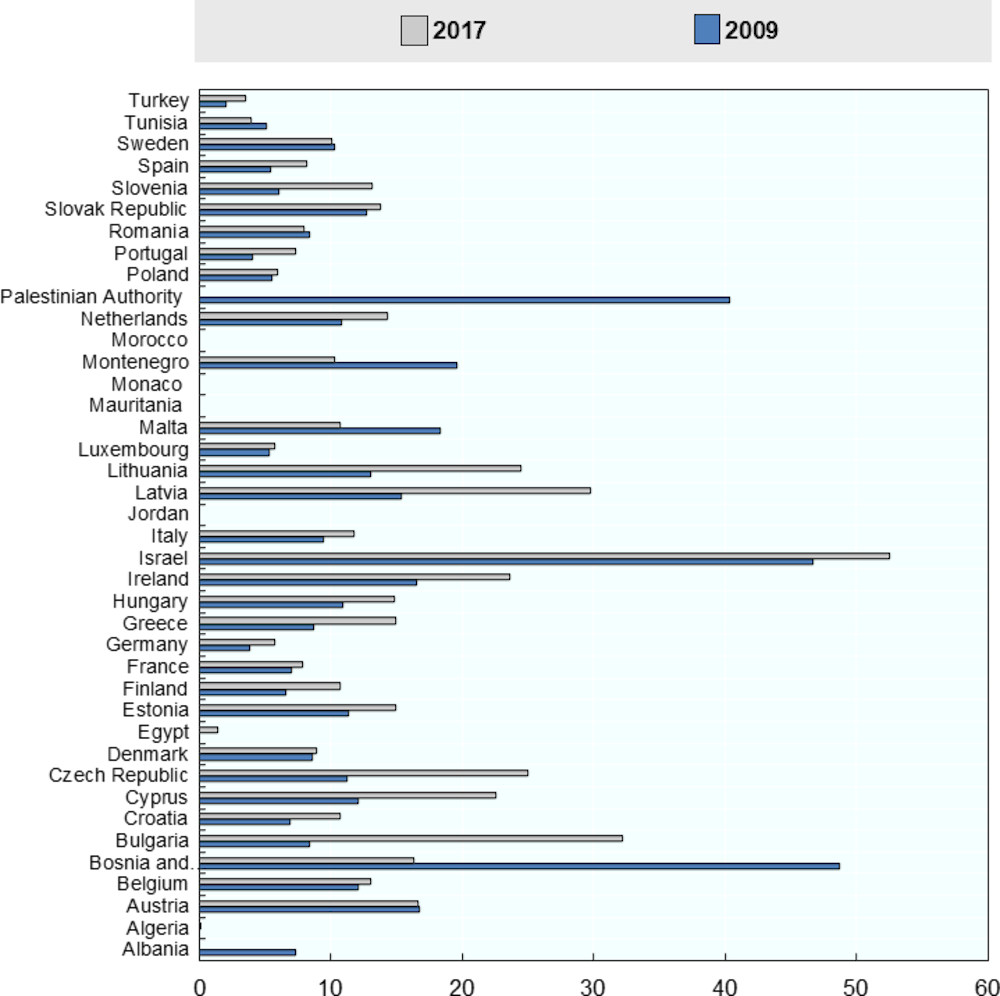
Note: 2009 data are missing for Egypt; 2017 data are missing for Albania and Palestinian Authority. Data for Jordan, Mauritania and Morocco are missing. Data for Algeria are available but the values are very low and not shown.
Source: UNESCO Institute for Statistics (2020), http://data.uis.unesco.org.
Especially important for R&D performed by higher education institutions and government research organisations are funds provided by the European Commission, the largest sums of which flow to Germany and the United Kingdom. These play a more important role in the United Kingdom, underpinning 7.4% of higher education and government R&D, compared to 3.9% in Germany – a share larger than that of any other Western European country, apart from Greece or Ireland (Figure 5.6). Indicators of large-scale international programmes – such as the EU Horizon Programmes, EUREKA or COST, and Joint Programming Initiatives (JPIs) – may also be open to associate and third countries and contain data on linkages between institutions in different countries.
Figure 5.6. European Commission funding of government and higher education R&D in Europe, 2015
EUR million PPPs, 2010 prices
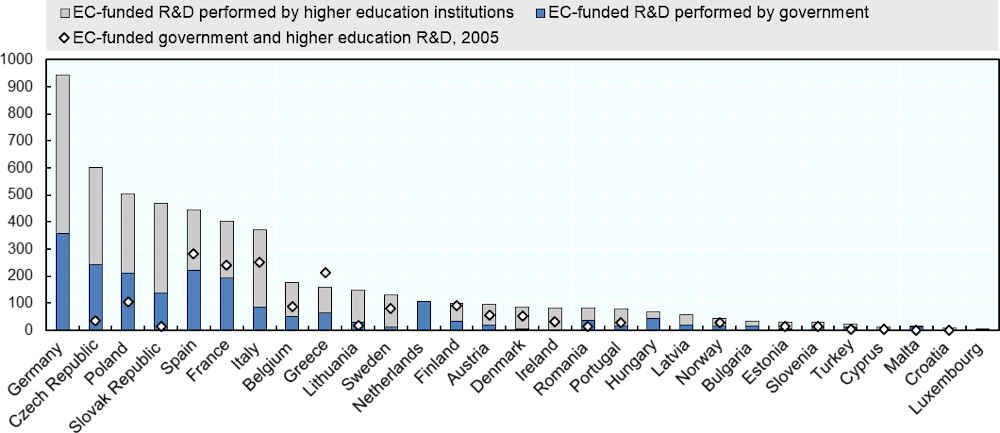
Source: OECD Research and Development Statistics Database, http://oe.cd/rds; Eurostat, Statistics on Research and Development; Eurostat, PPPs for ESA 2010 aggregates, 2018.
Indicator R4: R&D personnel
Research and development (R&D) personnel include all persons employed directly in R&D activities, including technicians and support staff as well as researchers. Researchers are defined as professionals engaged in the conception or creation of new knowledge. R&D personnel are represented in full-time equivalent units defined as the ratio of working hours actually spent on R&D during a specific reference period (usually a calendar year) divided by the total number of hours conventionally worked during the same period by an individual or a group. Figure 5.7 provides a measure of the importance of the research workforce in the economy. With a few exceptions, male researchers are predominant across countries of the UfM region.
Figure 5.7. Total R&D personnel per million inhabitants, by sex, 2008 and 2018, in selected UfM economies
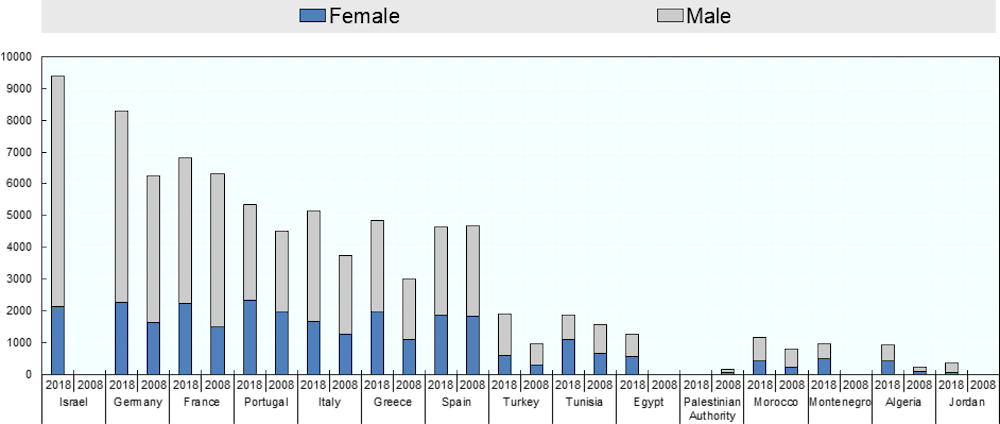
Note: For Israel, data refer to 2012. For Greece, data refer to 2007 and 2018. For Turkey, data refer to 2008 and 2017. For Tunisia, data refer to 2009 and 2018. For the Palestinian Authority, data refer to 2008 and 2013. For Morocco, data refer to 2008 and 2016. For Algeria, data refer to 2005 and 2017. For Jordan, data refer to 2015.
Source: UNESCO Institute for Statistics (2020), http://data.uis.unesco.org.
Indicator R5: Co-publication
International co-authorship of scientific publications is defined at the institutional level. A scientific document is deemed to involve an international collaboration if there are institutions from different countries or economies are present in the list of affiliations reported by single or multiple authors. Most estimates come from private databases such as Scopus1 and the Web of Science2. The analysis typically comprises the absolute numbers as well as the share of international co-publications out of all publications and out of all co-publications. Co-publication analysis shows the relative importance of international collaborations that lead to tangible outputs (publications) and the nature of these collaborations in terms of countries and disciplines. Some research fields, however, are more prone to co-publication than others. Indeed, some scholars have postulated that subject-specific cultures affect collaboration patterns and spatial dependencies (Henneman et al, 2012[15]).
Co-authorship measures are robust, probably more so than simple output figures (e.g. number of publications, either in absolute or in relative measures). Nonetheless, bibliometric indicators raise many questions, such as the relationship between co-authors and their institutions. Many scientists hold multiple affiliations, for example.
An analysis of co-publishing based on the Nature Index shows that scientific co-operation is characterised by North-South interactions and less by South-South collaboration, although there are exceptions (Egypt- Saudi Arabia, Morocco-Israel). Most scientific co-operation is organised around physical sciences and chemistry, as well as life sciences, areas that are important to industrial development (in particular the chemicals and petroleum industries). Scientific co-operation in the environment is less pronounced in both the Southern Mediterranean countries and EU countries compared to other disciplines (Figure 5.8). The data also show that, amongst UfM economies, Southern Mediterranean economies collaborate with four to seven other UfM economies out of their top ten collaborators: Albania (8); Israel (6); France and Germany (8 out of 9 southern UfM economies) followed by Italy (7) and Spain (5). In particular, in the field of chemistry, Algeria and Tunisia collaborate with France and Jordan collaborates strongly with Germany and the Czech Republic. In the earth and environment fields, Tunisia collaborates mainly with France. In the life sciences, Morocco collaborates mostly with France while Albania collaborates mainly with Germany and the United Kingdom. A breakdown for the physical sciences shows that Tunisia collaborates mainly with France.
Although scientific collaboration is strongly correlated with scientific and technological specialisations in countries, this does not mean that specialisations are static (OECD, 2017[7]). Indeed, publication data show that between 1981 and 2014 the disciplinary focus in chemical and petroleum engineering in Southern Mediterranean Middle East and North Africa (MENA) countries has waned, while there has been modest growth in the life sciences (Afreen S et al, 2016[16]). Although changing specialisations require time and investment in research equipment, institutions and human capital, the experience of OECD and former developing countries such as Korea show that specialisation patterns are shaped by higher education, research, and innovation policies, including those that encourage international scientific co-operation.
Figure 5.8. Top 10 overall collaborators among Southern Mediterranean UfM economies and European UfM countries
1 July 2019 to 29 June 2020
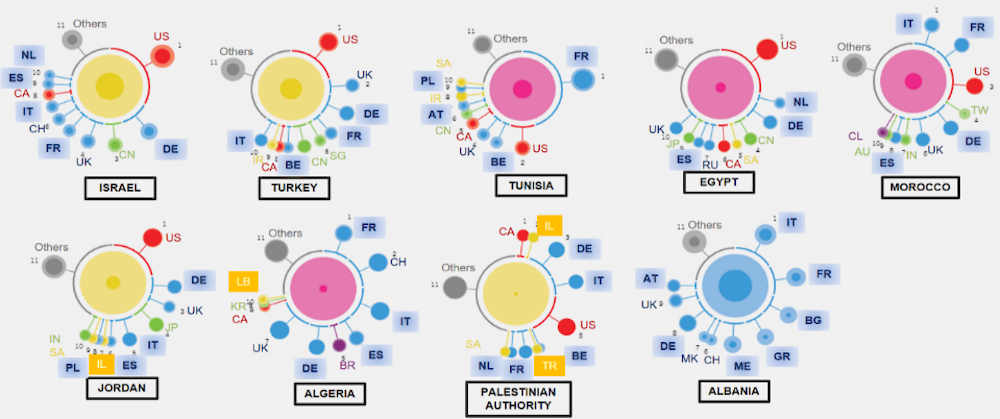
Note: Outside each circle, UfM countries are identified using coloured boxes.
Source: OECD based on NatureIndex.com, https://www.natureindex.com/institution-outputs/france/organisation-for-economic-co-operation-and-development-oecd/53a254c1140ba0165d00000a
Co-publication data can also be analysed by field of study. Figure 5.9 and Figure 5.10 show the co-publication profiles of countries in the Southern and Northern UfM economies, respectively. Generally, profiles reflect the comparative advantage of countries in scientific production, which is itself correlated with research priorities and industrial specialisations or niche strengths. Countries such as Albania, Algeria, Egypt and Tunisia have a strong co-publication focus in chemistry. Morocco and Tunisia also have strong pharmaceutical and food industries that rely on inputs from chemistry. Israel, Italy, Morocco and Turkey co-publish in the physical sciences; the Palestinian Authority and Jordan co-publish in the life sciences. Northern UfM economies have a more diversified pattern of co-publication and a greater share of co-publication in the life sciences, reflecting the growing share of research funding in the health sciences in many EU and OECD countries. Co-publication figures broken down by subject for the Southern UfM countries show that physical sciences are proportionally higher in Israel, Morocco and Turkey, while the earth and environmental sciences are high in Albania and chemistry is high in Algeria, Egypt and Tunisia.
Figure 5.9. Main areas of co-publication of Southern UfM countries, by subject
1 July 2019 to 29 June 2020
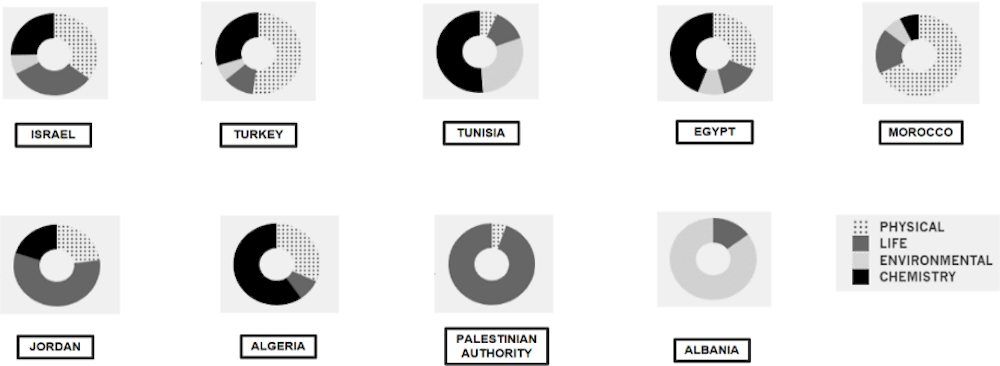
Note: These charts show collaboration with all countries (not only with Southern UfM countries).
Source: OECD based on NatureIndex.com, https://www.natureindex.com/institution-outputs/france/organisation-for-economic-co-operation-and-development-oecd/53a254c1140ba0165d00000a
Figure 5.10. Main areas of co-publication of Northern UfM countries, by subject
1 July 2019 to 29 June 2020
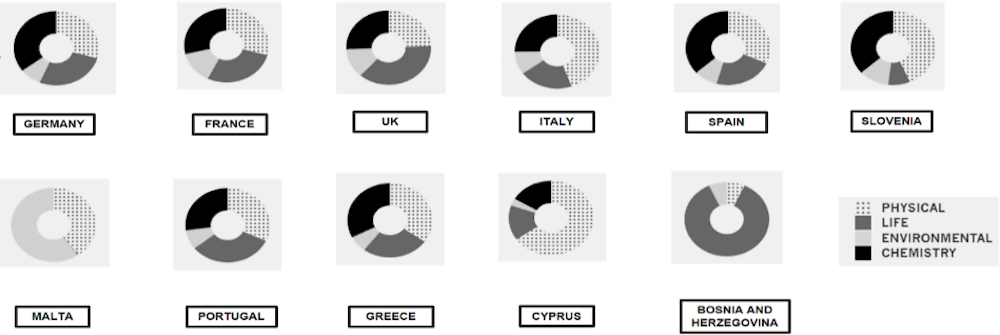
Note: These charts show collaboration with all countries (not only with Southern UfM countries).
Source: OECD based on NatureIndex.com , https://www.natureindex.com/institution-outputs/france/organisation-for-economic-co-operation-and-development-oecd/53a254c1140ba0165d00000a
Other indicators try to capture the relations established between different fields and between different institutions. These cognitive and relational indicators are usually more complex (Morini C et al, 2013[17]). Using co-publication data allows the development of network maps to illustrate the intensity of collaboration among partners. For instance, (Research Trends, 2010[18]) showed the relative strength of the collaboration among countries of the Organisation of Islamic Countries (OIC) during the period 2004-2008. Egypt appeared clearly as a hub connecting outliers. The network map also showed that OIC nations collaborated along geopolitical lines. Importantly, network maps also reflect the important role that individual researchers play (rather than governments and scientific organisations) in co-operation.
Indicator R6. Co-patenting
Co-patent analysis has been used to characterise the growth of international cooperation and patterns of partnerships (Guellec, D. and van Pottelsbergehe, 2001[19]). Patents are an indicator of inventive activity and a proxy for innovation. The number of patents per population in a country is indicative of its position in the global innovation ecosystem and the status of its knowledge economy. Countries with comparatively high intensity of patents per population are better able to take advantage of globalisation. International co-patents are measured as the share of patent applications with at least one co-inventor located in a different economy in total patent applications submitted domestically. Data on international co-patenting can be sorted by sectors, technical fields and by firm size (i.e. SMEs). Figure 5.11 shows that the main EU partners collaborating with Southern Mediterranean countries on inventions are France, the United Kingdom and Germany. The main co-inventing partners in the Southern Mediterranean countries for EU countries are Lebanon, Tunisia and Egypt, where co-inventions in the chemical and oil industries, light manufacturing, and business services are important.
Figure 5.11. Co-inventions between European and Southern Mediterranean countries, PCT (2008-16)
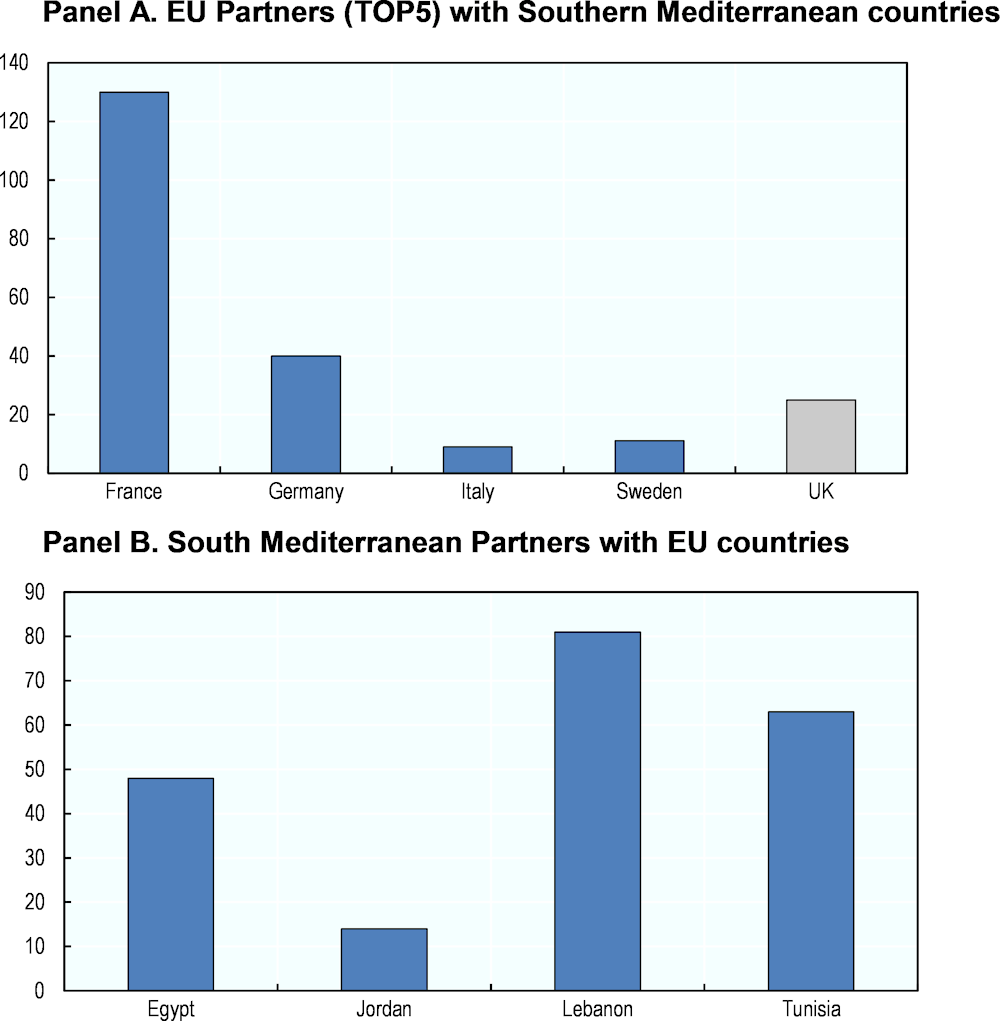
Note: During the period covered by these data, the UK was a member of UfM and the EU and is presented as such in this graph Panel A shows number of PCT co-application, between Southern Mediterranean countries (Egypt, Jordan, Lebanon and Tunisia) and each of EU countries: France, Germany, Italy, Sweden, and UK. Panel B shows number of PCT co-applications between EU countries: France, Germany, Italy, Sweden and UK, and each of Southern Mediterranean countries.
Source: OECD Patent Database (2020). https://www.wipo.int/pct/en
Important differences in co-invention exist across industries, reflecting the fact that some industries show a higher propensity to patent and a higher proportion of international co-invention (Figure 5.12).
Generally, a large number of international co-inventions are observed in industries such as chemicals, electronics and business services (Debacker k and Flaig D, 2017[20]). Other industries with a significant number of international co-inventions are machinery, whole/retail trade, hotels and restaurants. Intensities (international co-inventions as a percentage of PCT patents) show a somewhat different pattern, with high intensities in a number of industries that have a relatively small number of PCT patents (e.g. agriculture, mining, food and financial intermediation). For the other industries, the intensity varies between 4 and 10%.
Figure 5.12. International co-invention across industries, absolute numbers and intensity
1995-2019

Note: Intensity is measured as the number of international co-inventions expressed as percentage of the total number of PCT applications.
Source: Calculations based on OECD, STI Micro-data Lab: Intellectual Property Database, http://oe.cd/ipstats, and ORBIS©, version 2.2020, Bureau van Dijk, May 2021.
Indicator R7. Tertiary-level mobility
Data from UNESCO show that, amongst UfM countries sending 10 000 students, Albania sends most of its students to Italy; Algeria, Morocco and Tunisia send most to France; and Turkey sends most to Germany. Figure 5.13 shows that, amongst UfM countries receiving more than 10 000 students, France receives most of its foreign students from Morocco and Algeria, Italy receives most from Albania, and Germany receives most from Turkey and Tunisia. The United Kingdom receives most from Morocco, Egypt and Jordan (Figure 5.14).
Figure 5.13. International mobility of tertiary level students by country of destination, from Southern UfM to Northern UfM countries
As a percentage share of the total number, 2018
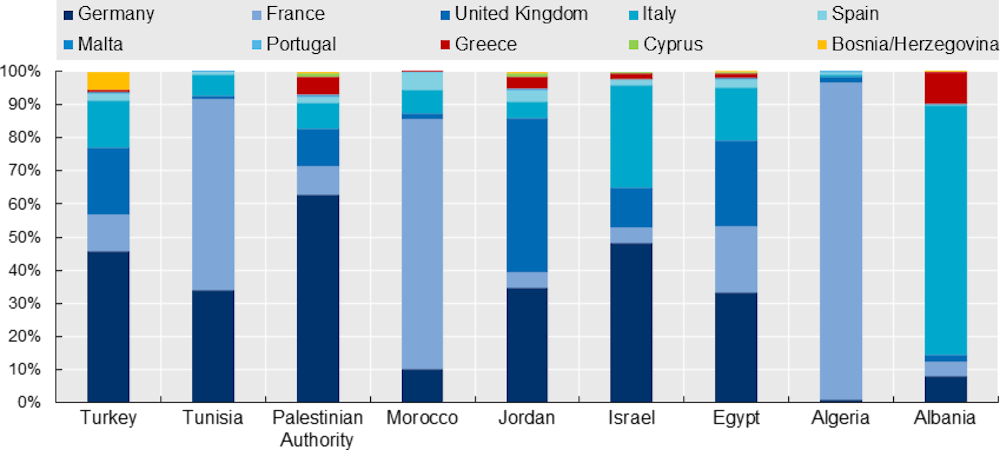
Note: During the period covered by the data, the UK was a member of the UfM and the EU, and is presented as such in the graph.
Source: OECD, based on UNESCO data "Global Flow of Tertiary-Level Students", http://uis.unesco.org/en/uis-student-flow.
Figure 5.14. International Mobility of Tertiary Students by origin from Southern UfM to North UfM countries
As a percentage share of the total number, 2018
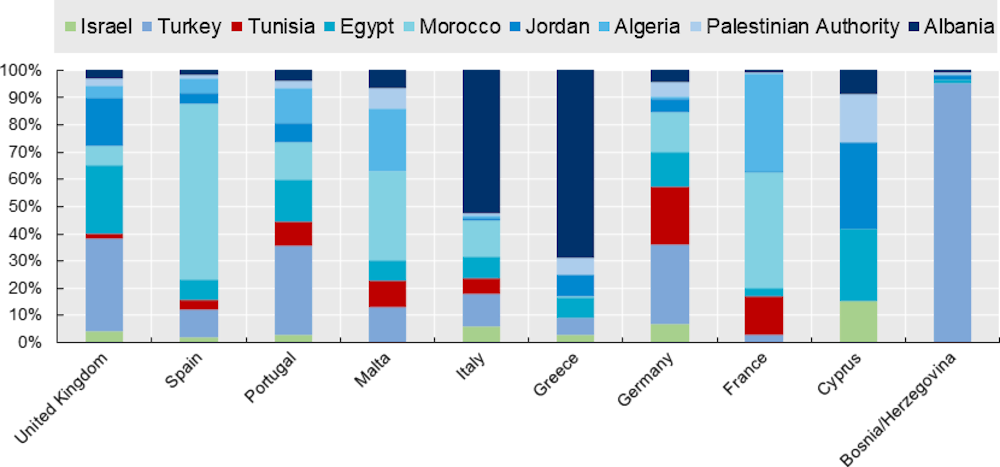
Note: During the period covered by the data, the UK was a member of the UfM and the EU and is presented as such in the graph.
Source: OECD, based on UNESCO data "Global Flow of Tertiary-Level Students", http://uis.unesco.org/en/uis-student-flow.
Figure 5.15 shows the ratio of students into the United Kingdom or France to the total of Europe in 2013 and 2017. Amongst five southern UfM countries (Egypt, Jordan, Lebanon, Morocco and Tunisia), the ratio of the United Kingdom dropped in Jordan from 2013 to 2017. Similarly, that of France dropped in Tunisia, Egypt and Lebanon. In contrast, that of France increased for Morocco. In France and the United Kingdom, the ratio of the Southern UfM countries except Morocco fell from 2013 to 2017.
Figure 5.15. The ratio of students from five UfM countries in France or the United Kingdom to the total of Europe
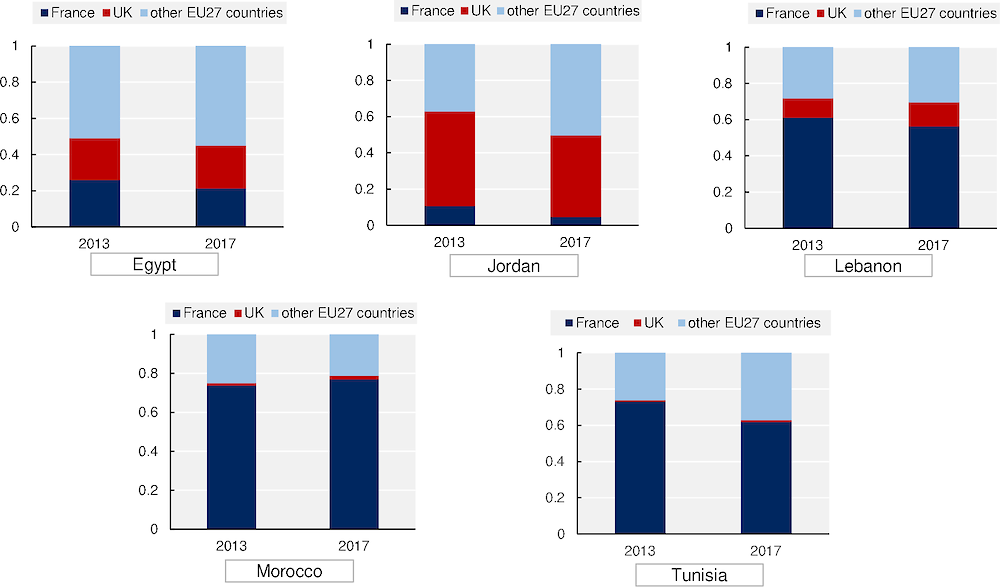
Note: During the period covered by the data, the UK was a member of the UfM and the EU and is presented as such in the graph. Europe includes EU27 countries. Total of Europe = 1
Source: OECD.Stat 2020, https://stats.oecd.org,
Figure 5.16 shows that among students from five UfM countries (Egypt, Jordan, Lebanon, Morocco and Tunisia) in Europe in 2017, the largest share came from Morocco (40 000). Egypt experienced the highest growth rate between 2013 and 2017 (more than 150%) following the economic and political changes in the country.
Figure 5.16. Number of students enrolled in different education programmes of Europe, by country of origin
Number of students and growth rate 2013-17
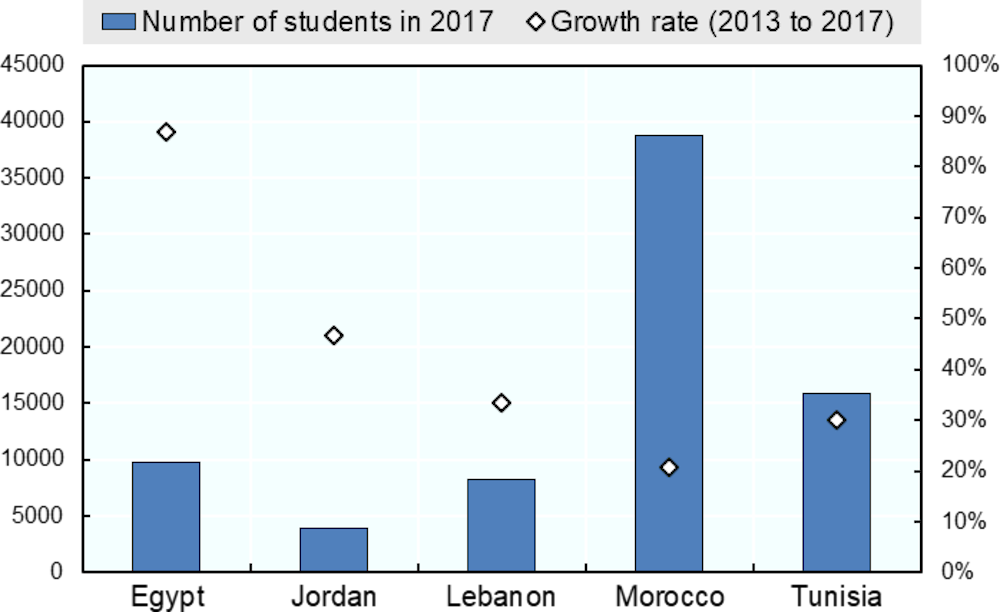
Note: Europe includes the United Kingdom and the following EU countries: Austria, Belgium, Czech Republic, Denmark, Finland, France, Germany, Greece, Hungary, Iceland, Ireland, Italy, Luxembourg, Netherlands, Poland, Portugal, Slovak Republic, Spain, Sweden, Estonia, Latvia, Lithuania, and Slovenia.
Source: OECD.Stat 2020, (https://stats.oecd.org),
Careers of Doctorate Holders
In many countries, indicators of “researchers” remain sparse because researcher are not a unique statistical category. The OECD Careers of Doctorate Holders project began collecting indicators to map the stocks and flows of PhDs. These indicators include (i) the circulation of doctoral researchers within the population of OECD countries and (ii) inflows of non-OECD researchers into the OECD (country of origin of non-OECD doctoral candidates in OECD universities; ratio of third-country to non-OECD doctoral candidates; etc.) (Auriol L et al, 2013[21]). At the national level, several countries (e.g. France, Portugal, Spain and the United States) conduct ad hoc surveys of their PhD holders.
A new survey of doctorate holders in France, for example, supports the notion of circular mobility of PhDs. Approximately 56% of PhDs who earned their doctorate in France in 2014 were employed in Europe (outside France) while 30% were employed in Africa in 2017, suggesting circular migration following doctoral education received in France (MESRI, 2020[22]).
Data from the OECD Education Directorate in Figure 5.17 show the share of doctoral students who are foreign-born or foreign citizens in a selected number of OECD and partner countries. This is an indicator of the stock rather than the flows of international PhD mobility; however, the coverage is limited to OECD countries and a select number of Partners. Many factors at the individual, institutional, national and global levels drive patterns of international PhD mobility. These include personal ambitions and lack of PhD programmes at home. This was the case, for example, in Korea in the 1980s and 1990s, when many students went abroad for PhD training in the United States.
Figure 5.17. Share of foreign-born and foreign citizen doctorate holders in the population, selected OECD and partner countries, 2016
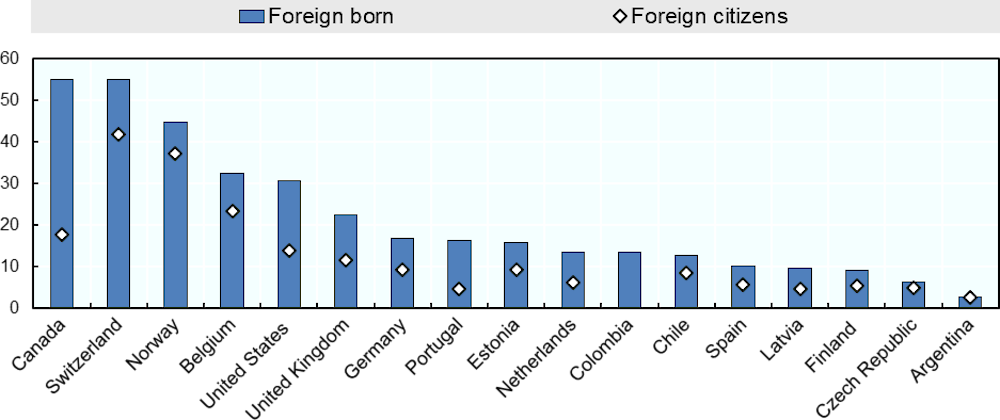
Note: Data for Chile, Latvia and the United States refer to 2015. data refer to 2015; Finland data refer to 2014. data refer to 2014; Netherlands data refer to 2013 data refer to 2013.
Source: OECD data collection on Careers of Doctorate Holders (2017), http://oe.cd/cdh
Indicator R8. Researcher mobility programmes
Regional integration and co-operation can also be observed through researcher mobility programmes. However, researcher mobility, in contrast to the mobility of highly skilled migration, is a smaller-scale phenomenon (Box 5.3). Some OECD countries have special visas for scientists and researchers, including for scientists fleeing conflict zones. Meanwhile, data for many UfM countries are inadequate.
One of the largest and most emblematic research mobility schemes is the EU’s Marie Skłodowska-Curie Actions (MSCA), a mobility fellowship that supports researchers at all stages of their careers, regardless of age and nationality. Researchers working across all disciplines are eligible for funding. The MSCA also supports co-operation between industry and academia and innovative training to enhance employability and career development. MSCA fellowships are open to UfM countries that participate as “Affiliate” or “Third Country” members. The data from the MSCA can be longitudinal or cross-sectional. Figure 5.18 illustrates the mobility of MSCA professional staff fellows between Egypt and other countries participating in the MSCA.
Figure 5.18. Research and Innovation Staff Mobility between Egypt and other countries in the Marie Curie Fellowship Programme in 2019
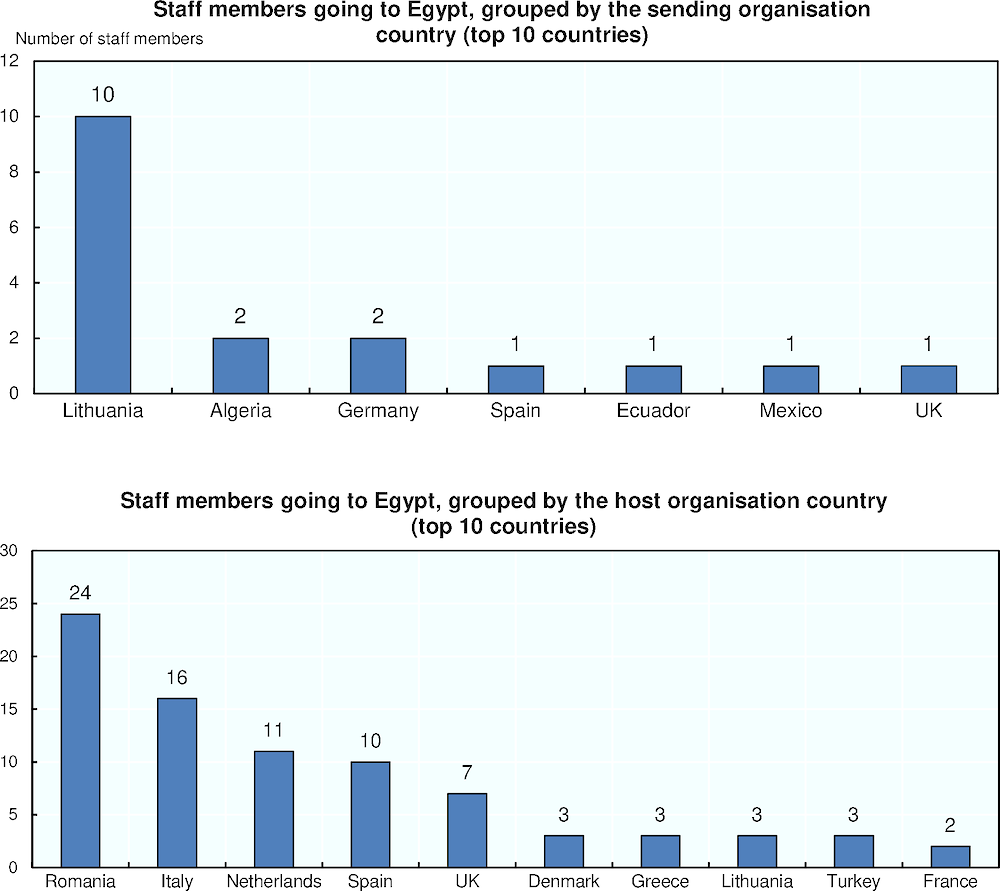
Source: European Commission, H2020 MSCA Country Fact Sheet for Egypt, https://ec.europa.eu/research/mariecurieactions/sites/mariecurie2/files/msca-country-profile-egypt-2019_en.pdf.
Box 5.3. Mobility of Highly Skilled Workers
While mobility of highly skilled workers is covered in Chapter 4 of this report, the issue remains relevant for monitoring knowledge networks of entrepreneurs. Existing research has largely focused on the analysis of specific categories of highly skilled migrants, such as those in human resources in science and technology (HRST); it finds evidence of the benefits of foreign HRST migrants for receiving countries in the OECD area (Guellec D. and Cervantes, 2008[23]).
In addition, several studies find that migrant entrepreneurs have a positive impact on trade between the home and host countries. Estimated effects vary considerably, ranging between 0.1% and 3.5% of increased trade due to a 10% increase in total migrant stock in the host country (Hatzigeorgiou A, 2010[24]). In another study, (Mahroum S et al., 2013[25]) finds that a migrants from MENA countries made significant contributions to science and engineering in the United States. Based on the data of 2,500 MENA individuals with patent documents from the World International Property Organization (WIPO), the study finds that the share of inventors in total US inventive activity with a MENA background has increased considerably in the last 20 years. MENA inventors in the United States concentrate in California and tend to specialise in computers, communication and software, as well as in medical and veterinary sciences. The study concludes that some countries, such as Saudi Arabia and Turkey, have contributed more to patenting activities than other nationalities such as Iran, which have a higher number of migrants in the United States, for historical reasons.
Conventional wisdom holds that the transfer of highly educated people from one country to another (commonly referred to as “brain drain”) will lead to a loss of productive and innovative capacity of the sending country. More recently, the concept of “brain circulation” has attracted policy attention since the temporary and circulatory migration between home and abroad may be beneficial to the sending countries. Individuals may transfer the knowledge they acquire to their home country and maintain networks abroad; they often return to the home country after a period abroad and will likewise transfer knowledge. In order to maximise the benefits from brain circulation, countries need to implement policies that ensure sufficient absorptive capacity. In particular, returning highly skilled professionals should be able to integrate into the local labour market at a level that is appropriate for their skills and knowledge.
Figure 5.19 presents, for Southern UfM countries, the various levels of funding of and participation in international EU collaborative research projects. Due to the SESAME infrastructure, Jordan and Morocco receive a significant amount of funds from the EU; however, participation in EU projects is higher among Egypt, Morocco and Tunisia.
Figure 5.19. Participation of Southern UfM countries in EU funding programmes, 2014-20
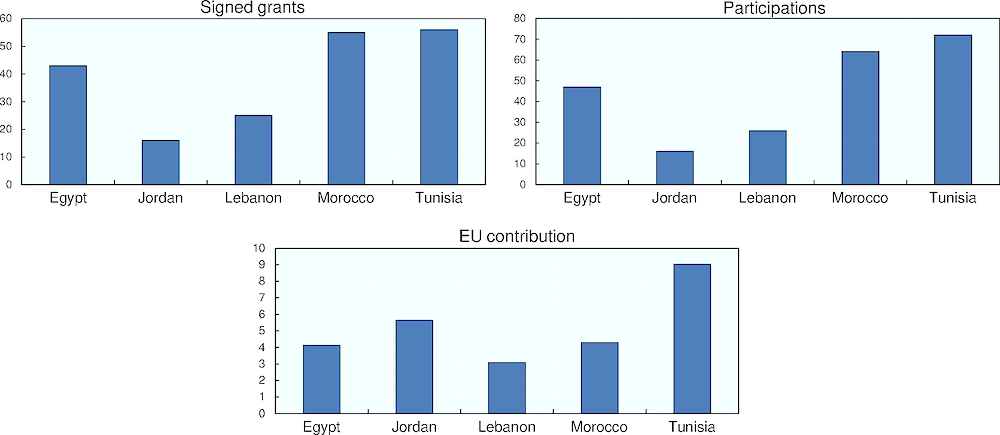
Source: Horizon Dashboard, https://ec.europa.eu/info/funding-tenders/opportunities/portal/screen/opportunities/horizon-dashboard.
Research infrastructures play an important role in scientific co-operation at the regional and national levels. Shared infrastructures are an effective mechanism for advancing knowledge when the costs of infrastructure exceed those that can be borne by a single country, or when the research problem is global (e.g. climate change, health, energy development or resource efficiency). Moreover, investment in international R&D infrastructure is essential to attracting international flows of R&D, human resources, and related high value-added activities. Among other advantages, the fruits of such investments are somewhat less internationally mobile than are the results of technology development programmes supported by public funds – indeed, there are strong and lasting regional agglomerations of technological expertise and economic impacts. In the Euro-Mediterranean region, the development of the Synchrotron-light for Experimental Science and Applications in the Middle East (SESAME) represents a watershed for international scientific co-operation in the region (Box 5.4). Whilst the focus of SESAME is on basic science, it has many applications that can be used to address global and regional challenges such as clean water, low-carbon energy and pollution.
Box 5.4. Synchrotron-light for Experimental Science and Applications in the Middle East (SESAME)
Located in Allan, Jordan, SESAME is the first major international scientific centre in the Middle East. SESAME was established through co-operation between the European Union and Southern Mediterranean countries. The idea of an international science effort in the Middle East was born in the mid-1980s, when physicist Abdus Salam, a Pakistani Nobel laureate, suggested establishing a synchrotron radiation facility in Bahrain. Current members are Cyprus, Egypt, Iran, Israel, Jordan, Pakistan, the Palestinian Authority and Turkey. Current observers are Brazil, Canada, the People’s Republic of China, the European Organization for Nuclear Research (CERN), the European Union, France, Germany, Greece, Italy, Japan, Kuwait, Portugal, Russian Federation, Spain, Sweden, Switzerland, the United Kingdom and the United States. SESAME is a remarkable example of how scientists can unite in the pursuit of knowledge, even among nations with longstanding political tensions.
Synchrotron light sources generate an intense light beam that can reveal the atomic structure of matter, making them a prized tool in biology, chemistry, archaeology and other disciplines. This potential for innovative research in diverse fields makes a synchrotron light source the ideal basis of the Middle East’s first major cooperative scientific facility. At SESAME, researchers from all member states have begun carrying out experiments which have the potential to promote the development of varied scientific fields in their home countries.
Source:Sesame, https://www.sesame.org.jo.
Conclusions and policy considerations
The main findings of the chapter include:
Changes in global trade patterns, the increased use of automation in manufacturing, and a trend toward re-shoring and near shoring in manufacturing and service sectors pose several challenges to the ability of Euro-Mediterranean countries to move up the value chain and increase participation in the global economy.
Complementary policies are needed in research, higher education and innovation to accompany efforts to promote economic diversification at the national level as well as regional economic integration.
Regional integration in research and higher education requires that countries share a vision and commitment to science, technology and innovation (STI), as a source of their own country’s economic and social development. In practice, this means that countries must establish pre-conditions to regional integration in higher education and research. They must invest in R&D and related knowledge-based assets to be able to absorb foreign technology, contribute to trade and exchange ideas through regional and international co-operation.
Available key indicators for monitoring regional integration in higher education and research show that integration in the Euro-Mediterranean region has increased unevenly in line with the growing but unequal capacity in education and research in Southern UfM countries and the Western Balkans. Several UfM countries have increased their investments in R&D over the past decade in particular Israel, Egypt and Algeria. In contrast, Spain, Greece, Tunisia and Montenegro have stagnated or fallen back.
Cross-border funding for R&D is an important indicator of international linkages. It represents between 5 and 10% of total expenditure in EU countries. In Southern UfM economies, with the exception of Israel and the Palestinian Authority, foreign funding accounts for 5% or less. The weight of foreign multinationals in the economy and in the domestic production of technology matters: in Austria and Ireland funds from abroad represent close to 15% or more of total GERD; in Israel, they represent over 40%.
The intensity of scientific co-operation in the Euro-Mediterranean region is characterised more by North-South interactions than by South-South collaboration, although there are exceptions (e.g. Morocco-Israel).
Most scientific co-operation is organised around physical sciences and chemistry as well as life sciences, areas that are important to industrial development. Although scientific co-operation in the environmental sciences is less strong in the Southern UfM countries, there is growing demand for research collaboration in this area given the potential regional impact of climate change on the region’s water, food and agricultural systems.
Indicators of co-publication and co-patenting show that historical relations and industrial/economic structure shape co-operation patterns. France and Germany are also the main partners in innovation for Southern Mediterranean countries based on co-patenting data. Specialisation and partnership patterns are not static and can be shaped by investments in funding, talent and research infrastructures that can generate new specialisations and broaden the range of potential partners.
Student mobility to the European Union shows a sustained increase for Southern Mediterranean countries. Morocco, Tunisia and Lebanon send the most students to EU countries. France and the United Kingdom attract most of the tertiary level students from the Southern Mediterranean. Despite the disruption to student mobility caused by the COVID-19 pandemic, digital technologies offer new opportunities for broadening participation in regional and international education.
Participation in international research collaboration can take many forms, from bilateral programmes to international collaborative programmes such as the European Union’s Horizon 2020. Besides offering a vehicle for sharing costs and improving the quality of scientific research and training, international research programmes are also a way to direct research towards common problems. Tunisia and Morocco lead in participation in EU Horizon programmes but Tunisia and Jordan lead in terms of the value of financing.
Research infrastructures play an important role in embedding technology in local economic production systems. National investments in national labs and in international R&D infrastructures such as SESAME can attract international flows of R&D, human resources, and related high-value-added activities. Infrastructures such as distributed research labs also have the potential to act as nodes or part of global research networks, fostering virtual mobility and “brain circulation” as an alternative to brain drain.
This is particularly important for countries in the Western Balkans such as Albania and Bosnia-Herzegovina, which have experienced high levels of scientific emigration. It is also relevant to promote brain circulation in countries like Greece and Italy that have historically suffered intra- European brain drain.
Innovation systems are only as strong as their weakest link. This applies to both national and regional/international innovation systems. Strengthening regional co-operation in the Euro- Mediterranean region will require action in several policy domains but especially policies to strengthen national systems so that domestic research and education can be linked with national production, i.e. “the knowledge triangle”. It will also require strengthening connections internationally, including through digitalisation of higher education and research infrastructures and greater use of open science/open data platforms (Figure 5.20). New funding programmes such as PRIMA offer an opportunity to internationalise the knowledge triangle in UfM countries and to focus research and education on concrete societal challenges related to the environment and the Sustainable Development Goals (SDGs). However, place-based policies or regional economic policies that strengthen the contribution of international collaborations to local development and entrepreneurship will be crucial to creating a virtuous cycle that reinforces the local and international attractiveness of regional knowledge and innovation hubs.
Figure 5.20. Priority domains of policy action to strengthen links between economy, research and higher education in the context of integration in the Euro-Mediterranean region

Note: Moocs refer to online education programmes.
Source: Authors.
Digital technologies such as open science platforms (e.g. the European Science Cloud or the African Open Science Platform) can accelerate the digitalisation of education and research to enable countries to take advantage of new opportunities for regional co-operation, especially in the current context of the COVID-19 pandemic, and should not be underestimated. Online learning can complement or substitute mobility programmes, in particular for short learning courses. Digital training in vocational education can also equip young people to engage in digital trade in services. Scientific research is increasingly data-driven, and it will be important to ensure that research personnel are equipped with the digital skills necessary to engage with peers around the world.
Rethinking regional co-operation in higher education and research in the context of its contribution to economic development in the Euro-Mediterranean region will also require a reflection on new measures and indicators. Key international statistical indicators focus mainly on proxies for the inputs and outputs of higher education and research collaboration and do not cover relational, institutional, scientific or business networks that would normally provide information on the relative importance of framework conditions and specific education and research policies. Especially in countries where comprehensive indicators of higher education and research are lacking, these relational indicators, based on non-administrative data (e.g . surveys or internet data scraping) could provide rapid insights to policy makers.
Many of the indicators that OECD countries have developed have sought to measure the contribution of international activities to enhancing the national quality of research, as well as the contribution of foreign high-skilled researchers and mobility to innovative start-ups and high-skilled employment. They have been designed from an internal perspective, i.e. from the standpoint of a ministry or funding agency seeking to monitor the impact of funding for international research co-operation. Therefore, while indicators of co- publication are important, they are insufficient for monitoring integration or cooperation on critical development challenges common to MENA countries – for example, water, agriculture or energy research.
There is a need for new, impact-oriented indicators that measure the concrete outcomes/outputs of scientific co-operation, not just accounting for who co-operates with whom or in what field. If the goal of the co-operation is to increase aggregate agricultural productivity as opposed to scientific productivity, the number of co-publications or co-patents in agriculture will not provide that. At best, they can provide a proxy for the intensity or quality of international research, but they cannot measure the contribution of investments in knowledge to solving specific regional problems.
Finally, there are significant gaps in existing key indicators regarding the contribution of international co-operation in research and higher education to place-based economic development – in terms of the places where new business are established or where the patents are applied to generate economic impacts. Research funding and mobility data grouped by gender or firm size is also patchy in a number of countries. Greater engagement between the national statistical systems of UfM countries, Eurostat and the OECD on statistics for science, higher education and innovation would benefit all parties involved in the monitoring of regional integration and in the design and assessment of higher education and research policies.
References
[16] Afreen S et al (2016), Scientific Wealth in Middle East and North Africa: Productivity, Indigeneity, and Specialty in 1981–2013, https://doi.org/10.1371/journal.pone.0164500.
[10] Ansell and Gash (2007), Collaborative Governance in Theory and Practice. Journal of Public Administration Research and Theory, 8, 543-571., http://dx.doi.org/10.1093/jopart/mum032.
[21] Auriol L et al (2013), “Careers of Doctorate Holders: Analysis of Labour Market and Mobility Indicators”, OECD Science, Technology and Industry Working Papers, No. 2013/4, OECD Publishing, Paris, https://dx.doi.org/10.1787/5k43nxgs289w-en.
[2] Busck, N. (ed.) (1990), Innovation, Competitiveness and Economic Integration..
[4] Cervantes (2017), Higher Education Institutions in the Knowledge Triangle, https://foresight-journal.hse.ru/data/2017/07/02/1171234391/2-Cervantes-27-42.pdf.
[20] Debacker k and Flaig D (2017), The Future of Global Value chains, Business as usual or “a new normal”?, https://doi.org/10.1787/d8da8760-en.
[14] Edler and Flanagan (2008), Drivers of policies for STI collaboration and indicators. Background Report 1: Key Themes from the Literature. Report to European Commission, DG Research,, https://www.research.manchester.ac.uk/portal/files/50598821/FULL_TEXT.PDF.
[11] Folke et al (2005), ADAPTIVE GOVERNANCE OF SOCIAL-ECOLOGICAL SYSTEMS, https://doi.org/10.1146/annurev.energy.30.050504.144511.
[12] Gawer (2014), Bridging differing perspectives on technological platforms: Toward an integrative framework, https://doi.org/10.1016/j.respol.2014.03.006.
[23] Guellec D. and Cervantes, M. (2008), International Mobility of Highly Skilled Workers: From statistical analysis to policy formulation, http://hdl.voced.edu.au/10707/98764.
[19] Guellec, D. and van Pottelsbergehe (2001), ““The internationalisation of technology analysed with Patent Data”, Research Policy, Vol. No. 30, pp. pp. 1253-1266, https://doi.org/10.1016/S0048-7333(00)00149-9.
[24] Hatzigeorgiou A (2010), “The contribution of migrants in enhancing foreign trade”, in: OECD, Open for Business: Migrant Entrepreneurship in OECD Countries (pp. 273-270), Paris: OECD Publishing., https://www.oecd.org/els/mig/Part%20II_Entrepreneurs_engl.pdf.
[15] Henneman et al (2012), “The Myth of Global Science Collaboration : Collaboration in epistemic communiities”, Journal of Informetrics, Vol. (2(, pp. 217-225, https://ideas.repec.org/a/eee/infome/v6y2012i2p217-225.html.
[8] Horizon (2020), The EU Framework Programme for Research and Innovation., https://ec.europa.eu/programmes/horizon2020/.
[25] Mahroum S et al. (2013), “Careers of Doctorate Holders: Analysis of Labour Market and Mobility Indicators”, OECD Science, Technology and Industry Working Papers, No. 2013/4, OECD Publishing, Paris, https://dx.doi.org/10.1787/5k43nxgs289w-en.
[22] MESRI (2020), Enquete IPDOC 2017 (MESRI/SIES), https://www.data.gouv.fr/fr/datasets/insertion-professionnelle-des-diplomes-de-doctorat-par-ensemble-universitaire/.
[17] Morini C et al (2013), Assessing international scientific cooperation in the Mediterranean region., https://www.documentation.ird.fr/hor/fdi:010061108.
[13] OECD (2021), Science, Technology and Innovation Outlook 2021, OECD Publishing, Paris, https://doi.org/10.1787/75f79015-en.
[7] OECD (2017), Science, Technology and Industry Scoreboard, https://doi.org/10.1787/20725345.
[6] OECD (2008), Open Innovation in Global Networks, OECD Publishing, Paris, https://doi.org/10.1787/9789264047693-en.
[9] OECD (2017a), National Treatment for Foreign-Controlled Enterprises.,, https://www.oecd.org/daf/inv/investment-policy/national-treatment-instrument-english.pdf.
[18] Research Trends (2010), Elsevier, https://www.researchtrends.com/issue21-january-2011/a-rebirth-of-science-in-islamic-countries/.
[3] Sjoer, E., B. Nørgaard and M. Goosens (2011), Implementing Tailor-made CEE in theory and in practice - The Knowledge Triangle as a Conceptual Tool;, https://www.semanticscholar.org/paper/Implementing-Tailor-Made-CEE-in-theory-and-in-The-a-Sjoer-N%C3%B8rgaard/fef83cd86a9251dff06ffd184993063fa60c9b51.
[5] United Nations (2020), Guidebook for the preparation of STI for SDGs Roadmaps, https://sustainabledevelopment.un.org/content/documents/26001Guidebook_STI_for_SDG_Roadmaps_First_Edition_clean0323.pdf.
[1] World Bank (2020), Trading together: Reviving Middle East and North Africa Regional Integration in the Post Covid Era, http://dx.doi.org/DOI: 10.1596/978-1-4648-1639-0.